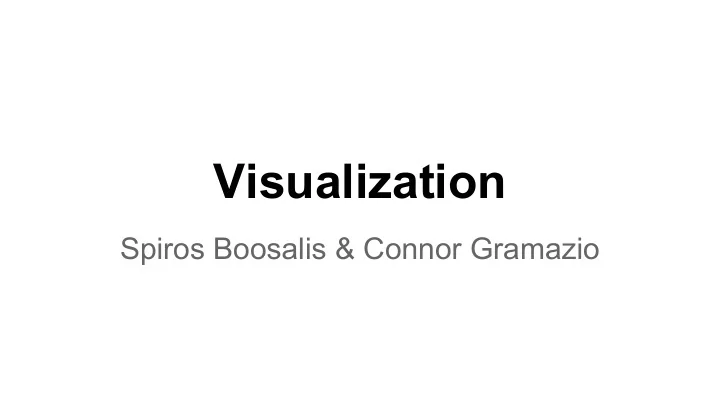

Visualization Spiros Boosalis & Connor Gramazio
Amanda Cox @ MIT, Tues Nov. 12 Very Small Arrays: Data Graphics at the New York Times Journalism has very little in common with big data. (The data in journalism is almost entirely tiny.) But there may be some similarities, at least in spirit: we both to know things we shouldn't be able to know, depend heavily on asking the right questions and quick iteration, and prefer way more detail than we actually need, at least at the beginning. I'll review some of the NYT graphics department's "bigger" data collaborations with academics and others, and discuss some of the broader trends in data visualization, as it is practiced by journalists trying to communicate with large audiences. https://calendar.csail.mit.edu/events/116379
Standard Fare
Why is it important to know about visualization?
The right viz for the right data Continuous data Discrete Data
Critiques
non grounded axis (12 ≠ ½ 16)
non grounded axis inconsistent axes
non grounded axis inconsistent axes chartjunk
The Question: how do the punishments for murdering someone and trafficking drugs compare?
bumps chart
(data, not visualization, but...) why not median?
compare gender compare income The Question: how does gender/wealth effect shopping online/offline?
bumps chart
What’s The Question?
What’s The Question?
The Question: how does the US’s life expectancy and health expenditures compare to other wealthy nations?
“US” is in bigger font
“US” is in bigger font the only color is “US”
“US” is in bigger font the only color is “US” clean axes (just min and max)
“US” is in bigger font the only color is “US” clean axes (just min and max) no other labels
Moving beyond the page: Interaction
Interaction should ● make sense ● combat visual complexity ● improve understanding
Interaction Taxonomy ● Select ● Explore ● Reconfigure ● Encode ● Abstract/Elaborate ● Filter ● Connect Yi, Ji Soo and Kang, Youn ah and Stasko, John and Jacko, Julie: Toward a Deeper Understanding of the Role of Interaction in Information Visualization,IEEE Transactions on Visualization and Computer Graphics, 2007
Select: mark something as interesting
Explore: show me something else
Reconfigure: show me a different arrangement
Encode: show me a different representation
Abstract/Elaborate: show me more or less detail
Filter: show me something conditionally
Connect: show me related items
d3
matplotlib gnuplot d3
d3.js ~ jquery (i.e. selectors and chaining) svg = d3.select(“#viz”) .append(“svg”) .attr("width", 800) .attr("height", 800)
d3.js separate data from visualization data = [32, 57, 112, 293] circle = svg.select(“circle”).append(“circle”) .data(data) circle.attr(“r”, function(d, i){d*d}) circle.attr(“cx”, function(d, i){i*100})
d3.js callback function(datum, index) {this} circle.data([32, 57, 112, 293]) => datum = 32 index = 0 this = <circle></circle>
d3.js extra data circle.enter() extra elems circle.exit()
d3.js transition = circle .transition() .delay(100) .duration(1000)
d3.js transition .style(“color”, “red”) .attr(“r”, 100) get starting values form DOM ( green and 10 ) get type of value ( color and number ) build interpolator schedule callbacks
Brushing
var focus = svg.append("g"), var x = d3.time.scale().range([0, width]), context = svg.append("g"); x2 = d3.time.scale().range([0, width]), y = d3.scale.linear().range([height, 0]), d3.csv("sp500.csv", function(error, data) { y2 = d3.scale.linear().range([height2, 0]); x.domain(d3.extent(data.map(function(d) { return d.date; }))); var brush = d3.svg.brush() y.domain([0, d3.max(data.map(function(d) { return d.price; .x(x2) }))]); .on("brush", actionOnBrushEventFn); x2.domain(x.domain()); y2.domain(y.domain()); var area = d3.svg.area() .interpolate("monotone") focus.append("path") .x(function(d) { return x(d.date); }) .datum(data) .y0(height) .attr("clip-path", "url(#clip)") .y1(function(d) { return y(d.price); }); .attr("d", area); var area2 = d3.svg.area() context.append("path") .interpolate("monotone") .datum(data) .x(function(d) { return x2(d.date); }) .attr("d", area2); .y0(height2) context.append("g") .y1(function(d) { return y2(d.price); }); .attr("class", "x brush") svg.append("defs").append("clipPath") .call(brush) .attr("id", "clip") .selectAll("rect") .append("rect") .attr("y", -6) .attr("width", width) .attr("height", height2 + 7); .attr("height", height); });
Resources d3: d3 homepage (filled with examples). StackOverflow: Mike Bostock, creator of d3, and other top contributors regularly answer questions. Crossfilter.js: JavaScript library for exploring large multivariate datasets in the browser. JunkCharts: critiques charts. d3 helloworld Supplementary or alternative libraries: ● dc.js: d3js + Crossfilter convenience library. Usable on top of vanilla d3. ● NVD3.js: d3 chart convenience library. Usable on top of vanilla d3. ● Vega: super simple json-based visualization generator. Built by Trifacta, a start up consisting of the Stanford viz crew (d3 and data wrangler folks) and other Bay-area viz folks. ● Chart.js: chart-only visualization library. Canvas-based (not d3), but easy and beautiful. ● CanvasJS: canvas-based visualization library.
Recommend
More recommend